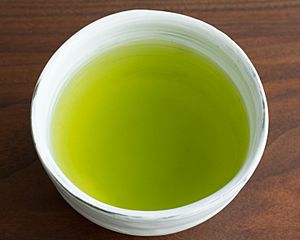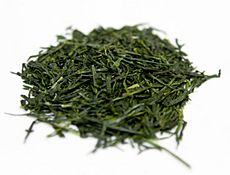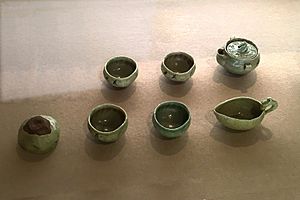Sencha facts for kids
| 2017 Kagoshima sencha.jpg | |
| Type: | Green |
|
|
|
| Other names: | Steeped Tea |
| Origin: | Japan |
|
|
|
| Quick description: | Very popular in Japan. |
|
|
|
| Temperature: | 80 °C (176 °F) |
| Time: | 1 min |
Sencha (煎茶) is a popular type of Japanese green tea. It's made by steeping whole tea leaves in hot water. This is different from matcha, which is a powdered green tea mixed directly into hot water. Sencha is the most common tea in Japan, and many people enjoy its fresh taste.
Contents
What is Sencha Tea?
Sencha is a special kind of green tea from Japan. It's different from other Japanese teas like gyokuro because it's not shaded as much, or not at all, during its growth. It's also different from bancha, which is picked later in the year. Sencha is super popular in Japan, making up about 80% of all the tea grown there!
When is Sencha Harvested?
The taste of sencha changes depending on when and where it's grown. The best kind is called shincha, or 'new tea'. This comes from the very first harvest of the year. Tea picking starts in southern Japan and moves north as spring arrives. During winter, tea plants store lots of good stuff. The new leaves that grow in spring are full of these nutrients. Shincha is made from these fresh, tender leaves.
The shincha season usually runs from early April to late May. A special day for picking is the 88th day after Setsubun, which is around February 4th. This day is traditionally seen as the start of spring in Japan. Drinking shincha on this day is thought to bring good health for the whole year.
What Does Sencha Look and Taste Like?
The perfect sencha drink has a lovely greenish-golden color. How it tastes also depends on the water temperature you use.
- If you use cooler water, the tea will taste smoother and milder.
- If you use hotter water, it will be a bit stronger and more bitter.
Some types of sencha even expand when steeped, looking and smelling a bit like leafy green vegetables!
How is Sencha Made?
The way sencha and other Japanese green teas are made is different from Chinese green teas.
- Steaming: First, Japanese tea leaves are steamed for about 15 to 20 seconds. This stops them from changing color and flavor (oxidizing). Chinese green teas are usually pan-fired instead.
- Rolling and Shaping: After steaming, the leaves are rolled and shaped. This gives them their usual thin, cylinder-like look.
- Drying and Sorting: Finally, the leaves are dried. Then, they are sorted into different quality groups.
The steaming step gives Japanese green tea its unique flavor. It often tastes a bit like vegetables or even seaweed. It's also greener in color and slightly more bitter than Chinese-style green teas.
Types of Sencha Tea
There are several kinds of sencha, each with its own special qualities:
- Jō Sencha (上煎茶): This is a superior, high-quality sencha.
- Tokujō Sencha (特上煎茶): This is an extra superior sencha, even better than Jō Sencha.
- Hachijūhachiya Sencha (八十八夜煎茶): This sencha is picked exactly 88 days after spring begins.
- Kabuse Sencha or kabusecha (かぶせ茶): This sencha is grown in the shade for a short time.
- Asamushi (浅蒸し): This means 'lightly steamed' sencha.
- Chumushi (中蒸し): This means 'middle steamed' sencha (steamed for 30-90 seconds).
- Fukamushi (深蒸し) or fukamushicha: This is 'deeply steamed' sencha (steamed for 1-2 minutes).
- Shincha (新茶) or ichibancha (一番茶): This is the very first sencha picked in the year.
Shincha: The New Tea
Shincha (新茶), which means 'new tea', is the first harvest of sencha each year. It's also called ichibancha (一番茶), meaning 'the first-picked tea'. Shincha is known for its super fresh smell and sweet taste. It's different from nibancha (second-picked tea) and sanbancha (third-picked tea). The name shincha really highlights that it's the earliest tea of the season. The opposite is kocha (古茶), or 'old tea', which is tea left over from the previous year.
Shincha has less of the bitter stuff like catechin and caffeine. Instead, it has more amino acids, which make it taste sweet. You can only get shincha for a short time each year. The first batches come from southern Japan around late April to May. It's very popular in Japan, but harder to find outside the country. People love it for its high vitamins, sweetness, grassy flavor, and very little bitterness.
Kabusecha: The Shaded Tea
Kabusecha (冠茶) is a type of sencha that is grown in the shade. About a week before the tea leaves are picked in spring, farmers cover the tea plants with a screen. This blocks direct sunlight. Shading the plants helps them produce more amino acids, like theanine, which give kabusecha its special, milder flavor.
This shading method makes kabusecha taste smoother than regular sencha. Another shaded tea, gyokuro, is shaded for an even longer time, about 20 days. Special nets called kabuse are used to create a natural shade without completely blocking the sun. Kabusecha sencha has a softer flavor and a more subtle color than sencha grown in full sunlight.
Senchadō: The Art of Sencha
Senchadō (煎茶道), which means 'Way of Sencha', is the formal art of enjoying sencha tea. It's a bit like a tea ceremony, but usually for high-quality teas like the gyokuro class. It involves special tools and a careful way of preparing and drinking the tea to fully appreciate its flavor and aroma.
See also
 In Spanish: Sencha para niños
In Spanish: Sencha para niños




